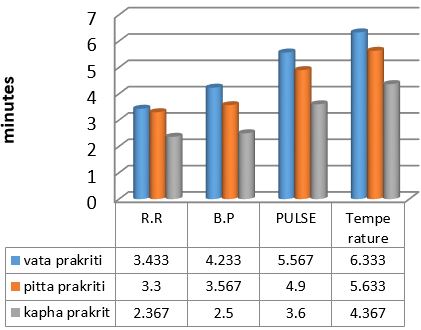Evaluation of Shareerika Bala in different Prakruti persons w.s.r. to Ardhashakti Vyayama
DOI:
https://doi.org/10.21760/jaims.9.7.11Keywords:
Shareerika Bala, Prakruti, Ardhashakti Vyayama, Individual's ConstitutionAbstract
Introduction: Bala is considered as the physical and mental strength of the individual. It can be assessed in healthy individuals as well as diseased. The Shareerika Bala in healthy individuals varies according to Prakruti, Vaya, Kala, Desha and others. Deha Bala of Vata Pradhana individuals have less Bala, Pitta Pradhana individuals have Madhyama and Kapha Pradhana individuals have more Bala. Bala can be assessed through one’s Vyayama Shakti. The optimum extent to which the Vyayama is to be performed is a question mark, as the Bala of Shareera varies in accordance with an individual and hence the Vyayama Shakti. To attain maximum benefits, practicing Vyayama to the optimum extent - Ardhashakti of Vyayama is of much importance. Methodology: In the present study 90 healthy individuals were made to run on electronic tread mill in Pratha Kala at a fixed speed for all and time taken to witness the Ardhashakti Lakshana and variations in the subjective and objective parameters were assessed statistically. Results: There is less time taken to attain Ardhashakti Vyayama Lakshana in Vata Pradhana Prakruti individuals i.e., 4.532 minutes, More time taken in Kapha Pradhana Prakruti individuals i.e., 6.191 minutes and time taken in Pitta Pradhana Prakruti individuals i.e., 5.562 minutes at ‘f’ value of 14.39 which is highly significant at p <0.05, 95% confidence level. Discussion: Ardha Shakti was more in Kapha Prakruti, less in Vata Prakruti, Madhyama in Pitta Pradhana Prakruti individuals. Hence the study established that Shareerika Bala was more in Kapha Pradhana Prakruti individuals than the Pitta and Vata Pradhana Prakruti individuals.
Downloads
References
Agnivesha. Charaka Samhita with Vaidyamanorama hindi commentary. Acharya Shukla Vidyadhara. & Acharya Tripathi Ravidatta. Reprint ed. Varanasi (India): Chaukambha Orientalia; 2011. Volume 1.p.171.
Acharya JT. Charaka Samhita with Ayurveda Dipika commentary of Chakrapani Datta. Reprint ed. Varanasi (India): Chaukambha Orientalia, 2000; 52.
Agnivesha, Charak Samhita. Sutrasthana. Vol. 7. Varanasi: Chaukhamba Bharti Academy; 1998. Vidyotini Hindi Commentry by Pt. Kashinath Shastri and Dr. Gorakhanath Chaturvedi; pp. 39–40.
Agnivesha, Charak Samhita. Vimansthan. Vol. 8. Varanasi: Chaukhamba Bharti Academy; 1998. Vidyotini Hindi Commentry by Pt. Kashinath Shastri and Dr. Gorakhanath Chaturvedi; p. 98.
Agnivesha, Charak Samhita. Vimansthan. Vol. 8. Varanasi: Chaukhamba Bharti Academy; 1998. Vidyotini Hindi Commentry by Pt. Kashinath Shastri and Dr. Gorakhanath Chaturvedi; p. 97.
Agnivesha, Charak Samhita. Vimansthan. Vol. 8. Varanasi: Chaukhamba Bharti Academy; 1998. Vidyotini Hindi Commentry by Pt. Kashinath Shastri and Dr. Gorakhanath Chaturvedi; p. 96.
Lakshmidhar Dwivedi (ed.), Caraka Samhita of Maharishi Agnivesa. Chaukhambha Krishnadas Academy, Varanasi. 2007 sutra sthan chap 7, verse 32. P. 181.
Susuruta Samhita, Ayurved sandeepika hindi vyakhya, by Ambikadatta shastri, Chaukhambha Sanskrit sansthaan Varanasi, edition2005, chikitsasthan chapter 24 peg no. 107 verse 47.














